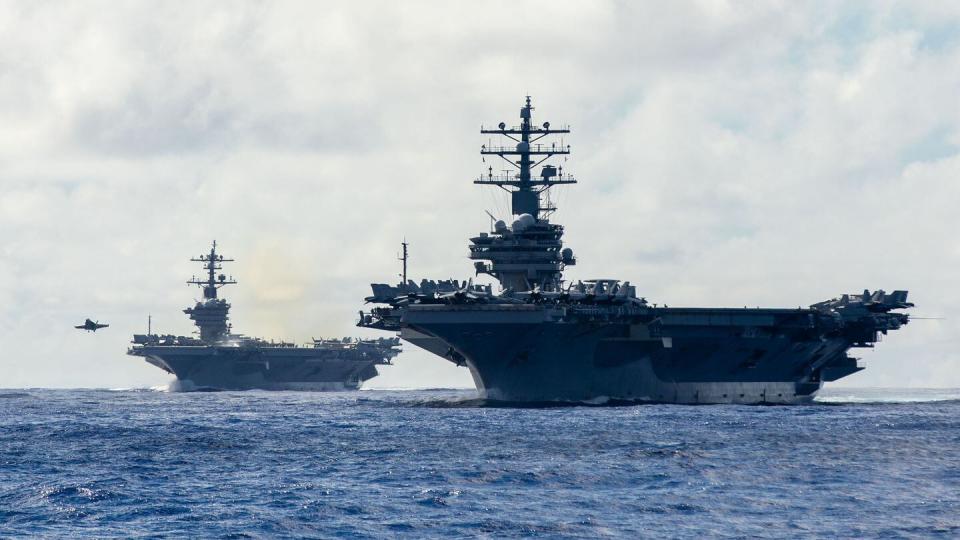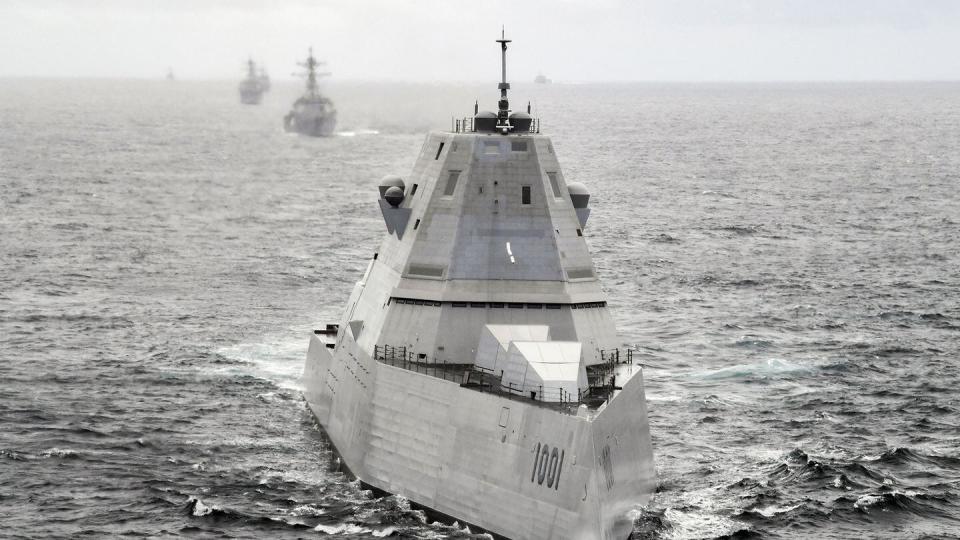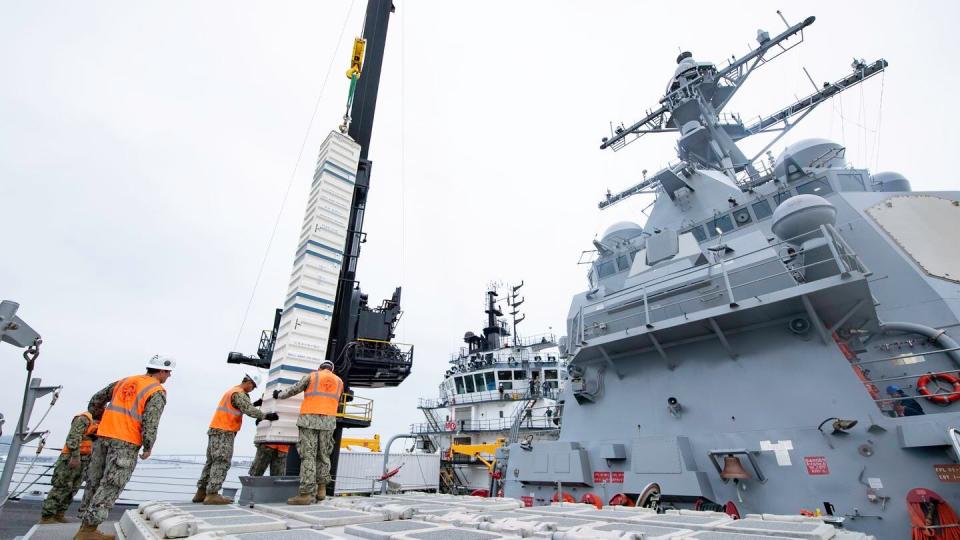House panel takes aim at Navy size, new capabilities in defense bill
A defense policy bill released this week by the House Armed Services Committee expresses concerns over the Navy’s aging cruisers, the cost and capability of a planned amphibious ship, development of capability to rearm vessels at sea, and more.
The language in the committee’s fiscal 2025 National Defense Authorization Act represents a continuation of disagreements between lawmakers and the sea service. The panel in recent years has clashed with the Navy in regard to balancing readiness, fleet size and the creation of next-generation technology.
Here are some of the issues House lawmakers take issue with.
Fleet size
As has been the case for years, the House Armed Services Committee is limiting how many Ticonderoga-class cruisers the Navy can retire. The service in its FY25 plan asked to retire four: USS Philippine Sea, USS Normandy, USS Shiloh and USS Lake Erie.
The committee’s version of the NDAA “would prohibit the retirement of the Guided Missile Cruisers USS Shiloh (CG 67) and USS Lake Erie (CG 70)”, as well as prevent the Navy from retiring or laying up more than two other cruisers.
The bill also calls for the Navy to buy a second Virginia-class submarine in FY25. This move sticks to the broader plan to buy two a year, but deviates from the Navy’s FY25 request for one per year, which reportedly took committee members by surprise.
More broadly, the committee takes issue with the Navy’s latest annual long-range shipbuilding plan, its budget request, and inconsistencies on near-term fleet size from one year’s plan to the next.
“This section would require the Navy to be consistent in the first 10-year planning window of the annual 30-year Shipbuilding Report to Congress,” the language reads.
If a plan would reduce the total number of ships in the fleet in that first 10 years compared to the previous year’s plan, the committee’s language would require the Navy to submit an additional assessment to describe how that reduction would support the National Security Strategy, what resources it would free up, how much money the shipbuilding industrial base would lose out on, how this would affect shipbuilders and lower-tier suppliers, and what the reductions would mean for the ship classes in question.

New ship programs
The committee and other congressional panels have expressed skepticism of new ship programs following challenges with the Littoral Combat Ship and Zumwalt-class destroyer programs as well as the first-in-class aircraft carrier Gerald R. Ford.
The House Armed Services Committee aims to exert additional oversight in its bill. The language asks for assurances from the Navy that, before construction begins, each new block of a ship will have its detail design completed, the Navy will obtain all information from its vendors about system maturity, and specifications will be finalized.
Specific to the current and future destroyer programs, the NDAA states: “The committee remains concerned about the ability of the Navy’s destroyers to meet future threats, especially as missile technology continues to advance.”
Noting the DDG(X) program for a next-generation destroyer will leverage both the Arleigh Burke and Zumwalt classes of destroyers, and that the Navy expects to spend more than $100 billion between 2019 and 2048 designing and building this class, the NDAA asks for:
The comptroller general of the United States to review how the service is developing its requirements and acquisition plan for DDG(X).
The status of the Flight III Arleigh Burke destroyers in their development, construction and testing phases.
The status of the Zumwalt class in its development, testing and modification phases for a new mission of surface strike, which includes being outfitted with hypersonic missiles.

The bill also calls for information on how the Navy will select the best propulsion system for the new ship. It notes two potential technologies — permanent magnet and high-temperature superconducting motors — and suggests the Navy develop both now to avoid a “late-stage failure in the selected motor technology [that] could significantly derail the lead ship’s schedule.”
On the Landing Ship Medium program for the planned amphibious ship, the bill would prevent the Navy from spending any money to buy these ships until the service secretary certifies the ship design is predominantly based on commercial specifications.
The Marine Corps wanted to begin buying these ships, previously called the light amphibious ship, in FY22. The program was delayed for budget reasons, but the Navy, Marine Corps and Office of the Secretary of Defense have spent the intervening years debating how to balance the desire to make these craft cheap and plentiful versus the desire to make them survivable during combat.
The Corps’ original vision was a commercial design that would blend in with local shipping and therefore create a level of safety for the Marines and sailors onboard, rather than having a military design that stands out from local boats but can take a hit and defend itself.
The NDAA language specifies the design should “not [be] based on more than 35 percent military specifications” and that the Navy secretary must detail to the committee “the differences in cost and construction schedules between a ship design based on military specifications and a design that uses commercial standards and elements.”
Weapons at sea
The committee took particular interest in the development of a rearm-at-sea capability, which Navy Secretary Carlos Del Toro has called a top priority, though it has so far eluded the service.
In one section, the NDAA would require the secretary to submit a strategy for delivering this capability to the fleet within three years of the bill becoming law. The strategy would outline current and planned spending on technology development as well as the anticipated cost and schedule to create this “transportable rearming mechanism equipment to load missile canisters into MK 41 vertical launch system cells on Navy destroyers operating” at sea.

The committee also notes it is “concerned that the Navy’s progress in developing this capability has been too slow and that the Navy’s leadership focus and resource investment is not sufficient to meet the Navy’s stated goals in this area. While the Navy has conducted demonstrations of certain steps in the process, significant challenges remain to be addressed before the Navy could effectively leverage this capability in a contested environment.”
It calls for a comptroller assessment of the Navy’s current and future spending and technology development efforts, as well as alternative courses of action.
The bill also calls for the comptroller to assess the Navy’s plan to develop and field long-range fires. It asks the secretary to brief the committee on plans to develop a passive long-range targeting kill chain system of systems, and how it will use additive manufacturing — or 3D printing — at the ship and unit levels.

